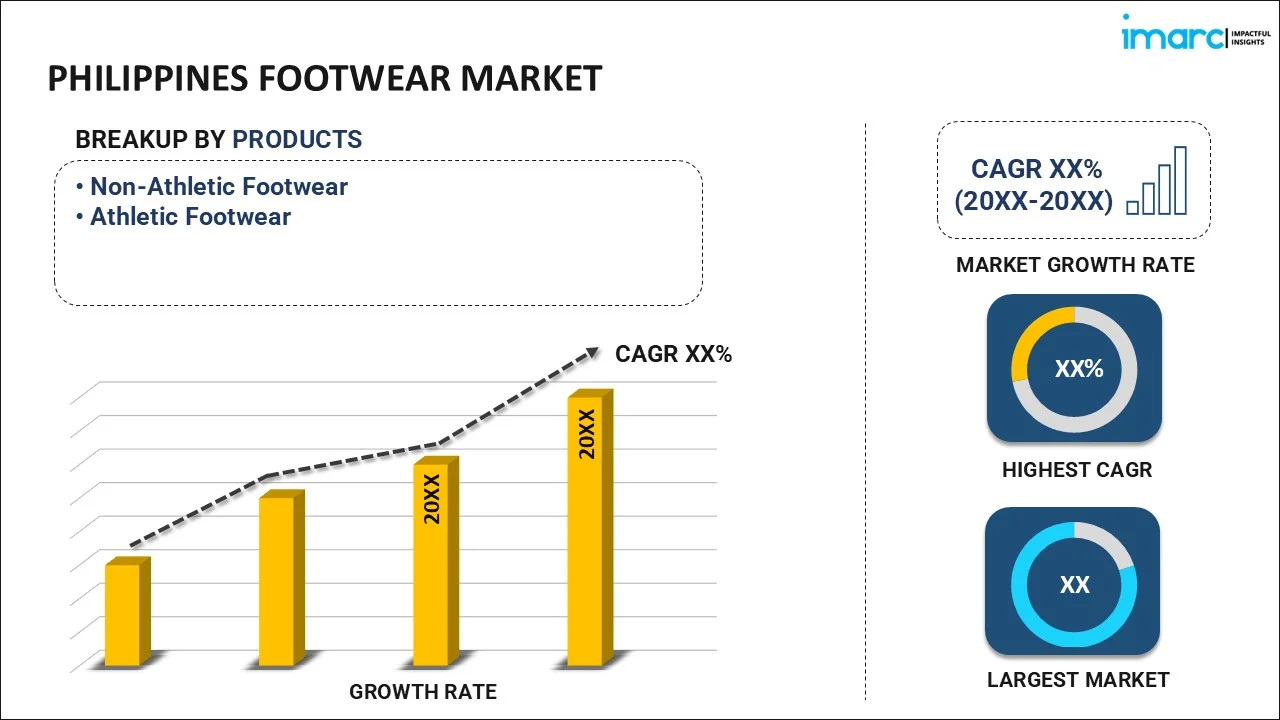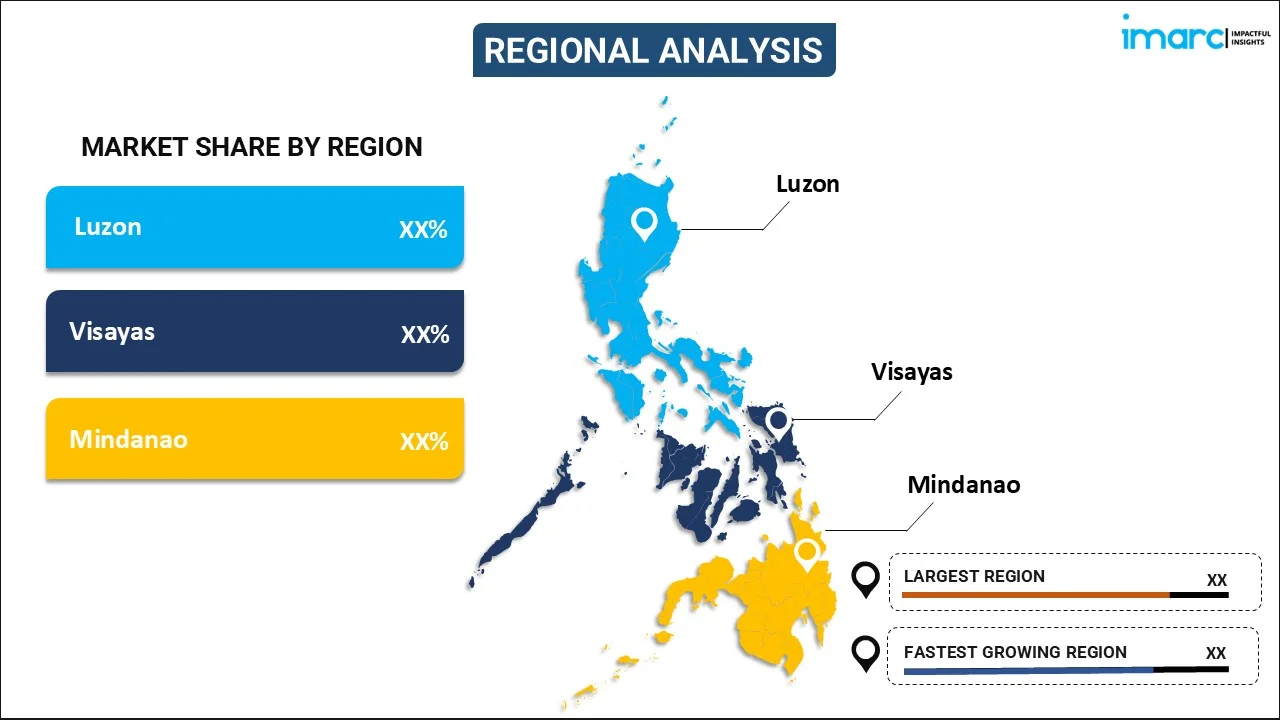
Philippines Footwear Market Size, Share, Trends, and Forecast by Product, Material, Distribution Channel, Pricing, End User and Region, 2025-2033
Philippines Footwear Market Overview:
The Philippines footwear market size reached USD 3.50 Billion in 2024. Looking forward, IMARC Group expects the market to reach USD 6.49 Billion by 2033, exhibiting a growth rate (CAGR) of 6.70% during 2025-2033. The market is driven by factors such as rising disposable income, rapid urbanization, growing e-commerce, increasing fashion consciousness, surging demand for sustainable products, expanding middle class, and widespread brand awareness, thus fueling its steady growth across diverse segments.
|
Report Attribute
|
Key Statistics
|
|---|---|
|
Base Year
|
2024 |
|
Forecast Years
|
2025-2033
|
|
Historical Years
|
2019-2024
|
| Market Size in 2024 | USD 3.50 Billion |
| Market Forecast in 2033 | USD 6.49 Billion |
| Market Growth Rate (2025-2033) | 6.70% |
Philippines Footwear Market Trends:
Growing Demand for Sustainable Footwear
The growing environmental consciousness in the Philippines leads consumers to choose sustainable along with eco-friendly footwear alternatives, boosting the Philippines footwear market growth. To align with these consumer demands, the brands incorporate materials that include recycled plastics, organic cotton, and biodegradable materials in their products. For instance, in February 2024, the Philippine government enacted the Tatak Pinoy Act to foster collaboration between the public and private sectors, encouraging industries, including footwear, to innovate and promote high-value goods, which aligns with the rise of sustainability. Moreover, eco-consciousness has become a dominant factor among modern buyers from the millennial and Generation Z groups, as they seek sustainable practices as well as responsible production standards. Besides this, local and international footwear brands engage in product development to offer environmentally responsible options, driven by this expanding trend. Furthermore, sustainable development initiatives by the Philippines government support the market expansion of products designed to minimize carbon emissions. As a result, the local market prioritizes long-lasting shoes with durability combined with fashionable design as its primary purchasing factor, thus impelling the market growth.
Rising Popularity of Athleisure Footwear
The Philippine market is experiencing a rising demand for athleisure footwear, driven by the changing lifestyles of people as they are focusing more on fitness and health. The market expansion in footwear also derives from the rising trend of uniting comfort with performance and fashion elements into one product. For example, the Department of Science and Technology-Philippine Textile Research Institute (DOST-PTRI) launched the 10th Filipino Footwear Design Competition, inviting local designers to create innovative footwear that highlights Filipino identity through storytelling, design, and materials. This initiative aims to promote the local footwear industry and encourage the use of sustainable materials and practices. In line with this, the market demands footwear products that combine the versatility to move between exercise activities and casual daily wear because an increasing number of people pursue dynamic lifestyles. Additionally, major international brands together with local manufacturers serve the increasing market demand by releasing comfortable shoes that blend athletic aesthetics with durability characteristics. Apart from this, fitness influencers on social media fuel the widespread acceptance of athleisure, even more rapidly as a mainstream fashion trend, which is enhancing the Philippines footwear market outlook.
E-Commerce and Online Shopping Surge
The Philippines footwear market share is witnessing a major transformation because of e-commerce expansion, as it provides consumers with a convenient and growing online shopping option. In confluence with this, mobile phones, better internet connectivity, and digital payment systems allow the footwear e-commerce segment to experience strong market growth. Moreover, the combination of simple browsing, competitive pricing, and home delivery services draws customers to online shopping. According to reports, 6% of Filipinos shop online more than once per month, with 11% shopping several times a week, indicating a strong shift towards online shopping. Concurrently, internet shopping solutions provide users with better opportunities to encounter brands while enabling them to build personalized connections which results in elevated customer trust. The footwear market also gets support from local stores and international brands that construct digital platforms and form alliances with online platforms to provide easy-to-use websites and mobile applications to their customers. As a result, the footwear market is experiencing an increased growth due to the permanent advantages of online shopping, thereby aiding the market growth.
Philippines Footwear Market Segmentation:
IMARC Group provides an analysis of the key trends in each segment of the market, along with forecasts at the region level for 2025-2033. Our report has categorized the market based on product, material, distribution channel, pricing, and end user.
Product Insights:

- Non-Athletic Footwear
- Athletic Footwear
The report has provided a detailed breakup and analysis of the market based on the product. This includes non-athletic footwear and athletic footwear.
Material Insights:
- Rubber
- Leather
- Plastic
- Fabric
- Others
A detailed breakup and analysis of the market based on the material have also been provided in the report. This includes rubber, leather, plastic, fabric, and others.
Distribution Channel Insights:
- Footwear Specialists
- Online Sales
- Supermarkets and Hypermarkets
- Departmental Stores
- Clothing Stores
- Others
The report has provided a detailed breakup and analysis of the market based on the distribution channel. This includes footwear specialists, online sales, supermarkets and hypermarkets, departmental stores, clothing stores, and others.
Pricing Insights:
- Premium
- Mass
A detailed breakup and analysis of the market based on the pricing have also been provided in the report. This includes premium and mass.
End User Insights:
- Men
- Women
- Kids
The report has provided a detailed breakup and analysis of the market based on the end user. This includes men, women, and kids.
Regional Insights:

- Luzon
- Visayas
- Mindanao
The report has also provided a comprehensive analysis of all the major regional markets, which include Luzon, Visayas, and Mindanao.
Competitive Landscape:
The market research report has also provided a comprehensive analysis of the competitive landscape. Competitive analysis such as market structure, key player positioning, top winning strategies, competitive dashboard, and company evaluation quadrant has been covered in the report. Also, detailed profiles of all major companies have been provided.
Philippines Footwear Market News:
- In November 2024, The Department of Trade and Industry (DTI) concluded its Trade Education and Advocacy (TEA) Campaign in Marikina, focusing on leveraging free trade agreements (FTAs) to enhance global market access for local footwear manufacturers.
- In July 2024, Toby's Sports was named Sporting Goods Retailer of the Year – Philippines at the Retail Asia Awards 2024, recognizing its 45 years of impact on the sports retail industry. Additionally, its commitment to providing high-performance, durable footwear tailored to the needs of local athletes and fitness enthusiasts strengthens its position as a key player in the growing footwear market in the Philippines.
Philippines Footwear Market Report Coverage:
| Report Features | Details |
|---|---|
| Base Year of the Analysis | 2024 |
| Historical Period | 2019-2024 |
| Forecast Period | 2025-2033 |
| Units | Billion USD |
| Scope of the Report |
Exploration of Historical Trends and Market Outlook, Industry Catalysts and Challenges, Segment-Wise Historical and Future Market Assessment:
|
| Products Covered | Non-Athletic Footwear, Athletic Footwear |
| Materials Covered | Rubber, Leather, Plastic, Fabric, Others |
| Distribution Channels Covered | Footwear Specialists, Online Sales, Supermarkets and Hypermarkets, Departmental Stores, Clothing Stores, Others |
| Pricings Covered | Premium, Mass |
| End Users Covered | Men, Women, Kids |
| Regions Covered | Luzon, Visayas, Mindanao |
| Customization Scope | 10% Free Customization |
| Post-Sale Analyst Support | 10-12 Weeks |
| Delivery Format | PDF and Excel through Email (We can also provide the editable version of the report in PPT/Word format on special request) |
Key Questions Answered in This Report:
- How has the Philippines footwear market performed so far and how will it perform in the coming years?
- What is the breakup of the Philippines footwear market on the basis of product?
- What is the breakup of the Philippines footwear market on the basis of material?
- What is the breakup of the Philippines footwear market on the basis of distribution channel?
- What is the breakup of the Philippines footwear market on the basis of pricing?
- What is the breakup of the Philippines footwear market on the basis of end user?
- What is the breakup of the Philippines footwear market on the basis of region?
- What are the various stages in the value chain of the Philippines footwear market?
- What are the key driving factors and challenges in the Philippines footwear?
- What is the structure of the Philippines footwear market and who are the key players?
- What is the degree of competition in the Philippines footwear market?
Key Benefits for Stakeholders:
- IMARC’s industry report offers a comprehensive quantitative analysis of various market segments, historical and current market trends, market forecasts, and dynamics of the Philippines footwear market from 2019-2033.
- The research report provides the latest information on the market drivers, challenges, and opportunities in the Philippines footwear market.
- Porter's five forces analysis assist stakeholders in assessing the impact of new entrants, competitive rivalry, supplier power, buyer power, and the threat of substitution. It helps stakeholders to analyze the level of competition within the Philippines footwear industry and its attractiveness.
- Competitive landscape allows stakeholders to understand their competitive environment and provides an insight into the current positions of key players in the market.
Need more help?
- Speak to our experienced analysts for insights on the current market scenarios.
- Include additional segments and countries to customize the report as per your requirement.
- Gain an unparalleled competitive advantage in your domain by understanding how to utilize the report and positively impacting your operations and revenue.
- For further assistance, please connect with our analysts.
 Inquire Before Buying
Inquire Before Buying
 Speak to an Analyst
Speak to an Analyst
 Request Brochure
Request Brochure
 Request Customization
Request Customization




.webp)




.webp)












